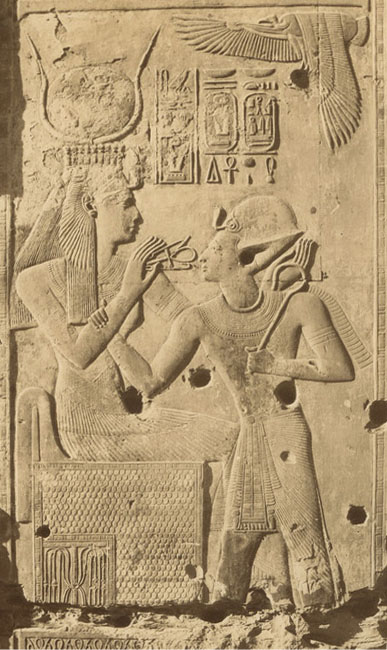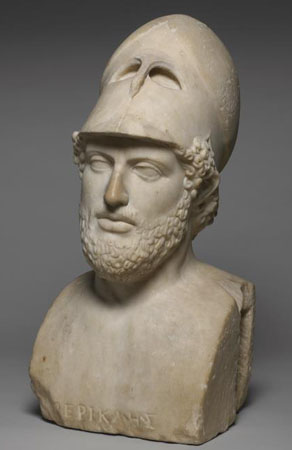Development of Roman Portraiture Art - Kori Alexander
 Bust of a Man, mid-1st century A.D.
Bust of a Man, mid-1st century A.D. |
The heyday of Roman portrait art was a period undoubtedly
enabled by the expression of the various cultures subsumed
by the tireless expansion of the Empire. In a plethora of
avenues of intellectual thought, as well as in the fine arts,
Roman contributions served as extensions and syntheses of
the works of the civilizations it absorbed. Indeed, the brilliance
of Roman portraiture art remains altogether indebted to the
artistic endeavors of cultures conquered as a result of Roman
military expansion. Out of the melting pot created by the
coalescing of these cultures arose art committed to depicting
the multi-dimensional aspects of character and personality.
The Western world was unique at the time. Rome was a power
that could not be rivaled by any in the world, a civilization
that crushed its adversaries in battle before they had a chance
to develop to the level at which they would pose a threat.
But, unlike conquerors of the past, they did not suffocate
the lifelines of creation within these cultures. Roman policy
dictated that its subjugate nations be allowed to continue
self-ruling, so long as they paid taxes to Rome and served
in the military of the Empire. Rome's defeated adversaries
were not often obliterated; but rather, they were able to
continue a modified way of life, so long as they were willing
to swear allegiance to the Empire. This created a loosely
knit community of subjugates that became dependent upon the
stability of Rome for their protection. While Rome embraced
foreign cultures and sought to export and disseminate their
value, it squelched any military development within its conquered
peoples. These factors created a hegemonic power, and the
co-mingling of prior civilizations became a hotbed for new
thought in arts, science, literature, and philosophy. Donald
Spanel argues- quite successfully- in his book Through
Ancient Eyes: Egyptian Portraiture that "the Western
concept of portrait is a work that reveals the inner and outer
qualities of a person who cannot be mistaken for anyone else."
(3). But, prior to the amalgamation
of cultures which occurred under the blanket of Roman rule,
the existence of portraiture art in this most archetypal sense
has been widely debated. It certainly seems true that, prior
to this period, the existence of portraiture served the specific
purposes of honoring the most distinguished individuals of
a society. The craft, prior to the existence of Hellenistic
influence, did not seem to have specific aims unto itself.
|
|
Ancient Egyptian art presents what may be considered early
forms of portraiture; but it does not seek to cultivate the
nectar that would, ultimately, render the process of portraiture
a form unto itself. That is, the endeavor to depict individual
personalities in art. Spanel, in his musings on Egyptian Portraiture,
notes that, "the modern analogue of the ancient Egyptian
approach to artistic representation is cubism, in which the
visual correspondence of an image to the model is emphatically
denied and is replaced by the juxtaposed and manifold facets
of the model's reality." Indeed, Egyptian art is
most immediately associated with rigid, geometrically composed
figures, variations on a type that remained unchanged for
hundreds of years. Yet, even in operating under such an unyielding
premise for style, Egyptian artists did not entirely neglect
their attention from the distinct characteristics of the faces
of individual persons.
Art historians, for example, have been able to note likeness'
between artistic representations and mummified remains of
Egyptian kings. This does not provide, however, a foolproof
rationale for the portraits being rendered for the sake of
depicting the "inner and outer qualities of a person."
Rather, it may simply just reinforce our current knowledge
of Egyptian religious practices. Denial of death was a notable
feature of Egyptian culture. Egyptians recognized a distinction
between the death of a physical body and the death of the
human soul. They believed that when the human body died, the
soul would remain in this world looking for a substitute residence.
Should it be unable to find a likeness of its former self,
it would wander confusedly until the end of days. Anxious,
unhoused souls did not bode well, so the Egyptians did deviate
from general type art to provide representations of individuals.
Yet, because these representations were likely produced only
to satisfy religious ends, they cannot be said to qualify
(as least in a Western sense) as authentic portraits (Hinks,
9-10).
Furthermore, it is apparent that the aims of Egyptian artists
lie in other avenues than those that would lead them to depict
individual personalities. While facial characteristics do
occasionally spring up, the likeness' depicted are form fitted
to a sort of mold. They are intended to produce an image that
will reflect the model as an adherent to the social, ethical
and moral values of their culture. As the Empire commissioned
funerary portraits, artisans were most likely not valued for-
or expected to- render art that would reflect upon the individual
and the true characteristics possessed by him or her. The
principle was to make a lasting positive impression of the
Empire and, accordingly, its absolute monarchs. A comparison
between the mummified remains of Seti I and his depiction
on the funerary temple at Abydos will display these points
brilliantly.
|
 Relief from Temple of Seti I
Relief from Temple of Seti I
New Kingdom - Dynasty XIX |
 Roman Copy
Roman Copy |
Hellenistic, or Greek, influence had much to do
with the development of Roman portrait art. Greek art from the
fifth century B.C. began to display a curiosity regarding individual
characteristics. But, like the Egyptians before them, these
portraits are still idealized likenesses. "The artist
has started out with the known personality of Pericles,
and has set out to create (sic.) the type of perfect
statesman and embody it in a plastic shape" (Hicks,
14). Though it is infinitely more anatomically correct
than the Egyptian portrait of Seti I, the two are comparable
in their depiction of a type or mold, rather than the distinctive
combination of facial traits and personal virtues that combine
to build a personality. |
The bust of Antisthenes from a century and half later is, however,
a stark contrast. This Hellenistic portrait boasts a remarkable
nose, an un-beautifully furrowed brow and deep-set eyes plagued
by depth and shadow. The conception of the soul as the real "self"
is attributed to Socrates, living from the later part of the fifth
through the majority of the fourth century. This development in
philosophical and psychological thought undeniably gains credence
in the better works of the later half of the fourth century B.C.
Antisthenes, next to Pericles, is like a Barbie doll next to Keith
Richards. Comb-toothed skin and anatomical perfections have caved
to flesh and character. Even the silver coinage, called tetradrachms,
are revealing of the ongoing development of the approach to the
portrait. The depiction of the double chin on Antichous I demonstrates
technique akin to that of a caricaturist. Adjacent to an understanding
of the character of the subject comes the comedy of imagining his
wobbling chin and beakish nose. He looks meddlesome and physically
weak simply as a result of his having these physical features. Yet,
the tact of the artist in rendering this portrait of personality
is not to be discounted. The artist must have taken some pains to
ignore the minute detail of wrinkles, warts, moles, facial scars
and otherwise to arrive at a singular concept of personality and,
then, to rebuild all of these irregularities for the purpose of
emphasizing only a few (Hinks, 33-35).
By the heart of the Roman Hellenistic period, personality is the
crux of portraiture. The synthesis of Greek attention to an inner
psychological context of thought combined with the distinctively
Roman development of extracting every detail of physiognomic relativity
renders masterful works like the stature of the Unknown Greek. He
is more realistically alive than either the sculpture of Antisthenes
or the silver tetradrachms. He is more anatomically clear than Antisthenes,
whose Greek sculptor succeeded in giving his piece a definite suggestion
of inner context but fell short of the fine wrought technique seen
here. His facial irregularities are not caricatured into exaggeration
or understatement. He seems real, as though one could walk up to
him and shake his hand and have no more or less revealed (in terms
of appearance) than they would from an ordinary person.
The Western concept of the craft of Portraiture first germinated
under the ideal conditions of the Roman Empire and would lay the
stage for works so precise and intuitively fashioned that, subsequent
to the collapse of Rome, their attention to the portrayal of individual
personalities would not again be rivaled until the end of the Middle
Ages.
The Roman Empire was a fulcrum upon which stability and, accordingly-
the fate the arts- rested. For the Western World during it's time,
Roman culture possessed the power to ignite innovation. But, in
its appetite for geographical expansion, it simply became too large,
too gregarious to manage. At the same time, the collapse of order
in the leadership which now lorded over the remnants of many ancient
civilizations caused a chain reaction of smaller collapses in these
subjugate provinces.
Rome tied everything together. And, when she fell, she took with
her all of the cultures she had once consumed. After hundreds of
years of Roman rule and Roman protection, these cultures had ceased
to remain secular. The melting pot of Rome had deprived them of
their own leadership, politics, culture and religion. The western
world was to be steeped in the chaos and disorganization of the
Dark Ages, and into this void disappeared the ripe conditions that
had borne such authoritative portraits.
(references on file with instructor)
next
| contents 2004 | home
|


